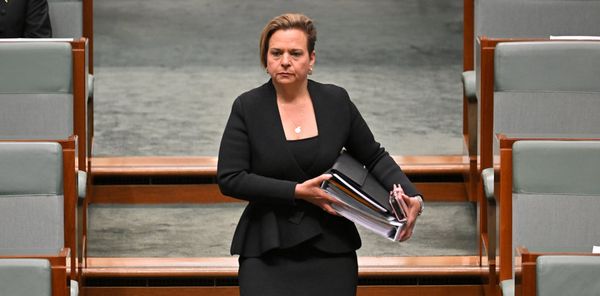
Two months ago, football administrator Heather Reid went diving into her archives for days on end after receiving a seemingly innocuous query. The question came from the sport’s governing body, Football Australia: “I was asked: could I help them put together a list of all the captains for the national team throughout our journey since the first AWSA [Australian Women’s Soccer Association] team was formed,” Reid says.
It sent her searching through the records to produce, for the first time, a comprehensive summary of every captain, head coach and team manager involved since the national side, now called the Matildas, was formed 45 years ago. On the eve of the Women’s World Cup, the document is a fitting tribute to the long and winding history of the Australian women’s football team.
First on the list is the Women’s World Invitational Tournament in Taiwan in 1978, with the team captained by Connie Selby (née Byrnes), coached by Jim Selby and overseen by the late Elaine Watson as head of delegation. It was the first Australian team, selected by an AWSA-appointed national coach at a national championship – but because their opponents were largely clubs, the matches have not been counted as “A” internationals.
“In the early years, a lot of the tournaments featured teams with country names – the USA, or Austria say – but they were in fact club teams,” Reid says.
The first A internationals came the following year, a three-match series against New Zealand in Australia. The Matildas were captained by Julie Dolan, with Jim Selby and Watson again involved, and Noelene Stanley.

Reid’s list goes on – 34 women have captained the Matildas (36 if Connie Selby and Michelle Sawyers, another former B international captain, are counted) – despite Wikipedia only listing 11 captains. The team has been overseen by 16 coaches, with only Tom Sermanni having two stints in charge. In the early decades heads of delegations and team managers were volunteers, while coaches were paid measly contract fees. It was not until the mid-1990s when Sermanni and his successors were engaged full-time to lead the team.
Reid was one such volunteer, first involved at the third World Women’s Invitation Tournament in Taiwan in 1984. “Quite often we paid our own fare to have the privilege of managing the team on tours to places like Hawaii, Noumea or China,” she says.
At that time, the Matildas’ primary opponent was New Zealand, and the team also went two years without a match, in 1992 and 1993. But momentum picked up in the mid-90s, with the first World Cup appearance in 1995 and their first Olympics at the Sydney 2000 Games.
The rest is history – with the Matildas emerging as a force in the women’s game, including winning the Asian Cup in 2010. On Friday, the team – now captained by Sam Kerr – will play France in a warmup match ahead of the World Cup.

***
Reid was the right person for the task, having had a ring-side seat to the rise of the Matildas since the early days. A longtime sports administrator, Reid ran the peak body for football in Canberra for almost a decade, served on the Football Australia board and was a member of the women’s football development committee. She was also in the room when a number of consequential moments in the history of women’s football happened.
“In 1987 I was talking to a group of people in Taiwan [at the final World Invitational Tournament] when we got news that Fifa would endorse a pilot World Cup the following year in China,” she says. “And I reflect on being part of a group of similar people who met in a hotel room in China in 1988 to talk about getting Olympic status for women’s football.”
Reid says the Olympics development, announced in 1993 ahead of the 1996 Games, was a pivotal moment for the sport in Australia. “The world changed,” she says. “With Olympics status, women’s football was able to attract federal government money through the Australian Institute of Sport, full-time scholarship places and national training centres in key states with high-performance training environments.” That Sydney was announced as the host of the 2000 Olympics in the same week, guaranteeing the Matildas qualification, was icing on the cake.
Reid developed the captains list with the help of Watson’s 1994 book, Australian Women’s Soccer – The First 20 Years, as well as the archival website OzFootball.net and personal records of more than a dozen individuals involved with the team. It was a labour of love consuming many hours. “I was a secretary by trade, so I type well,” Reid says.
Her spreadsheet still contains a few question marks. In March 1995, the Matildas played New Zealand twice in Canberra. “Coach Tom Sermanni can’t remember who his manager was,” Reid says. “But I think it would have been someone already on the list – Kerry Harris, Sarah Groube or Michelle Sawyers or someone like that – I think I have captured everybody.”

It has been a trip down memory lane leaving Reid with a feeling of pride at the growth of the sport. “I’m just proud of where we’ve come in such a short time,” she says.
Reid began working as AWSA executive director in 1986. “Times were tough – it was just me, an electric typewriter and a landline phone to start,” she says. With a group of pioneers – she lists Watson, Peta Winzar, Stephanie Quinn – they opened an office in suburban Canberra. “That was the start of taking Australian women’s soccer from kitchen table volunteerism to trying to make it more professional.”
Almost four decades later, the first Women’s World Cup on home soil begins next week. “We’ve seen tremendous change,” Reid says. “I’m very excited to be part of that change and excited about a unique World Cup, co-hosted by our sisters across the [Tasman] ditch. We can celebrate the fact that the women’s game has come of age.”
It will be Reid’s seventh Women’s World Cup – she believes she is the only Australian to have been at all but two editions of the tournament. “I just can’t wait,” she says. “It’s going to be huge.”







